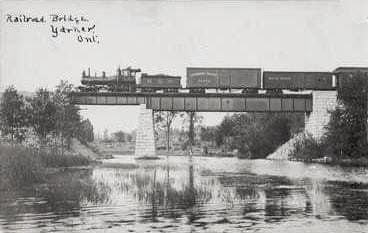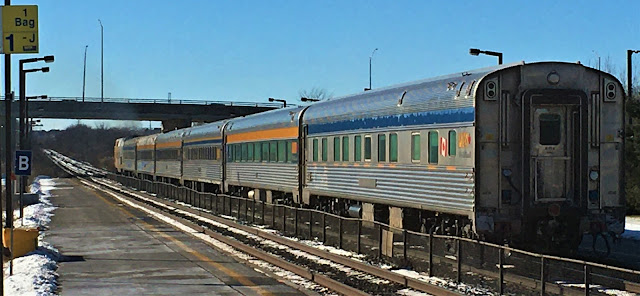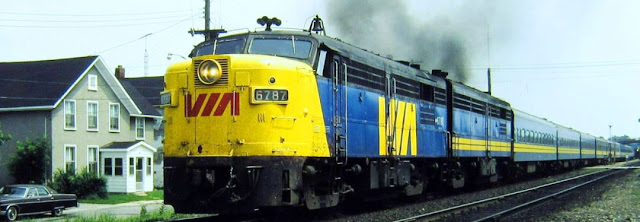The Napanee, Tamworth & Quebec (NT&Q) Railway Co. was granted its charter on May 15, 1879. From a connection with the Grand Trunk Railway (GTR) at Napanee, up through the Napanee River valley via Newburgh and Yarker to Tamworth, with an option to extend towards the Ottawa River near Renfrew via Arden. Iron ore deposits had been discovered near Tamworth that year. The 28-mile NT&Q route would be U-shaped, from Napanee to Napanee Mills (Strathcona), Camden East, Yarker, Moscow, Enterprise and Tamworth.
Early construction costs led to financial difficulties in 1882. New management in 1883 included chief investor Edward W Rathbun of Deseronto. Rathbun, a local business magnate, already had a Napanee-Deseronto line, the Bay of Quinte Railway (BQR). Napanee would therefore become merely a way station of Rathbun's newly-envisioned extension west to Tweed, and east to the Kingston & Pembroke (K&P) line. Lennox Member of Parliament John A. Macdonald may have been instrumental in securing Dominion government subsidies of $3,200 per mile. Rail was laid to Newburgh by November 17, 1883; Yarker by the first week of December; and near Moscow by Christmas that year. Additional rock work at Yarker would be required to reduce the grade. North and west of Yarker, the line turned progressively from farmland to Canadian Shield. Maximum speed on the new line was 25 mph. The inaugural train traversed the line departing Napanee on August 4, 1884. A Whig ad published November 10, 1884 mentioned the station under Yarker Notes:

Three views of the Yarker station, showing the 'Wagar family' and the others looking toward Napanee:
A Kingston extension was proposed, to be a bridge line to bring material to Kingston: minerals, grain timber and ore. The first proposed extension to be built to Kingston would go through Wilton, Odessa, Westbrook, Collins Bay, and Portsmouth. Instead, in 1888, Rathbun applied to build a seven-mile branch from Yarker to Harrowsmith thence Kingston via running rights over the K&P. (The proposed line to reach the K&P would have saved 25 minutes of time and six miles of distance, compared to the NT&Q's eventual route to Harrowsmith.) A 22-mile extension to Tweed, later extended to Bannockburn after 1903, was also proposed, all intended to extend Rathbun's commmercial reach. Extensions to Harrowsmith and Bannockburn were secured by 1889.
Yarker was chosen as the Napanee-Tweed mainline departure point for the NT&Q extension to Harrowsmith, three miles shorter than the originally surveyed point near Moscow. The branch to Harrowsmith did not incorporate a direct connection for traffic between Kingston and Napanee. This would save the expense of building another bridge across the Napanee River at Yarker. For expediency, the departure point was set just north of Yarker station. Harrowsmith-Yarker-Napanee traffic would be handled via a wye at the junction. The only available location for the wye was west of the mainline at Yarker, just past the connection to the Harrowsmith branchline, due to the proximity of the Napanee River. Additional land had to be secured for the wye to be built. The wye required a seesaw movement of east-west traffic, for example from Napanee north past the station, back the train into the wye, exit south leg of wye and head east on branchline. Two trains having negotiated the wye, head east across the original bridge toward Harrowsmith. The second [one version colourized] and third views are vintage photos, the second is from a vintage postcard captioned 1908:



A westbound train traverses the bridge in the opposite direction, heading into Yarker:
Cut stone abutments and the single pier for the two-span deck plate girder bridge began in the spring of 1889, spanning the connection running from just north of Yarker station thence eastward. The bridge was completed by November, 1889 (shown below in 1895). The Harrowsmith branchline was fit for use by November 19. 1889, laid with 56-lb rail. The first train operated between Tweed and Deseronto on December 1, 1889, and the first Tweed-Kingston train operated December 2.
The NT&Q changed its name to the Kingston, Napanee & Western Railway Co. on April 24, 1890. Traffic flow was Tweed-Deseronto, through two daily trains each way Tweed to Kingston, and one daily Deseronto-Yarker train each way. The K&NW was leased to the Bay of Quinte Railway on Sept. 24, 1891 then incorporated in to the BQR on January 1, 1897. When Rathbun died in 1903 at age 61, his empire rapidly disintegrated.
In turn, the BQR was acquired by MacKenzie, Mann & Co. as part of their Canadian Northern (CNoR) Toronto-Ottawa line. They installed the missing link at Yarker, building a deck girder bridge across the Napanee River in 1912. This direct link, which left the mainline farther south, finally eliminated the time-consuming switching movements required by trains heading east to Harrowsmith. Two photos of the construction - bridge pier forms (Pinterest image) and installation of spans:

MacKenzie and Mann also realigned their line through Newburgh, moving it north away from the Napanee River in 1914. This realignment may have been due to potential flooding, or to bypass the town, though it definitely reduced the grade eastbound. BQR became part of the their Canadian Northern Railway (CNoR) on January 5, 1914, bought at 70% of its original value. Two schedules from the June, 1916 Official Guide of the Railways: Kingston-Yarker; Toronto-Ottawa; Deseronto-Yarker:
Kingston-Yarker; Tweed-Deseronto; Deseronto-Bannockburn:
CNoR's poor financial straits saw its progressive amalgamation into Canadian National Railways from 1917 to 1923. As a result, the NT&Q, K&NW, BQR disappeared into the national railway. CN abandoned the Yarker-Tweed segment in 1941, and the Yarker-Smiths Falls (extended via subsequent extensions from Harrowsmith to Sydenham and east) in 1986. I'm not sure when the first bridge's spans were removed, but it's likely they were reused elsewhere on the system.
Approach to the second bridge, in 1958 (above). Unless otherwise noted, photos in this post, most originally from the Lennox & Addington County Archives published in the excellent book: Lost Horizons - The Story of the Rathbun Railway Company and the Bay of Quinte Railway - by Donald Wilson, Mika Publishing, 1983.
Undated (likely late 1940's, early 1950s) aerial views Queen's University Archives, George Lilley Fonds: V25.5-48-78/79 Yarker; V25.5-48-69 Strathcona; V25.5-48-53 Newburgh:
Yarker (above) showing the second bridge at centre, road overpass and first bridge abutments, and the curve at left heading north to Colebrook. A second view of Yarker (top photo) shows the second bridge, with the right-of-way of the former Harrowsmith extension just visible, curving up to left.
Strathcona (above) with several CN boxcars at the mill and the siding along the line. Newburgh, with two boxcars just visible near top of photo on the relocated ex-CNoR line and the Napanee River at near bottom:
My son and family took a recent stroll along the Cataraqui Trail and across the bridge, which sparked my interest in finally putting in the work to research this well-known local bridge and its interesting story. As with all other railway engineering, nature is always vying for supremacy - grapevines spread their tentacles over the side fencing along the bridge deck. I wonder if my four year-old grandson, walking with my son, could imagine CNoR steam-hauled passenger trains speeding across the bridge a century ago? From here looking upstream, the central pier of the first bridge is still visible:
Lots o' links:
Lesley
Bernard kindly shared this view of the piers and abutments of the first Yarker bridge circa 2007. Lesley knows a thing or two about the Tweed extension!
Running extra...
On March 26, the Ottawa Valley Associated Railroaders are holding a model train event a.k.a. flea market Sun: 9am to 5pm at the Hellenic Centre, 1315 Prince of Wales Drive in Ottawa. Admission $5. Table prices: $20 for OVAR Members, $25 Non-Members.
This is Trackside Treasure's 800th post, and this blog's 15th August anniversary arrives this summer! The same day, I reached 800 follower on Pinterest. Pinteresting coincidence.
If only that 40-mile Communist convoy, presenting such a fat target, and a pathetic picture of poor military planning, on its illegal invasion incursion into Ukraine, could have been destroyed one year ago. I'll continue to raise my Ukraine flag in our front window each day until the final Victory.
Slava Ukraini! Heroyam Slava! Glory to Ukraine! Glory to the Heroes!
















.JPG)
.JPG)
.JPG)














.jpg)
.jpg)
.jpg)
















